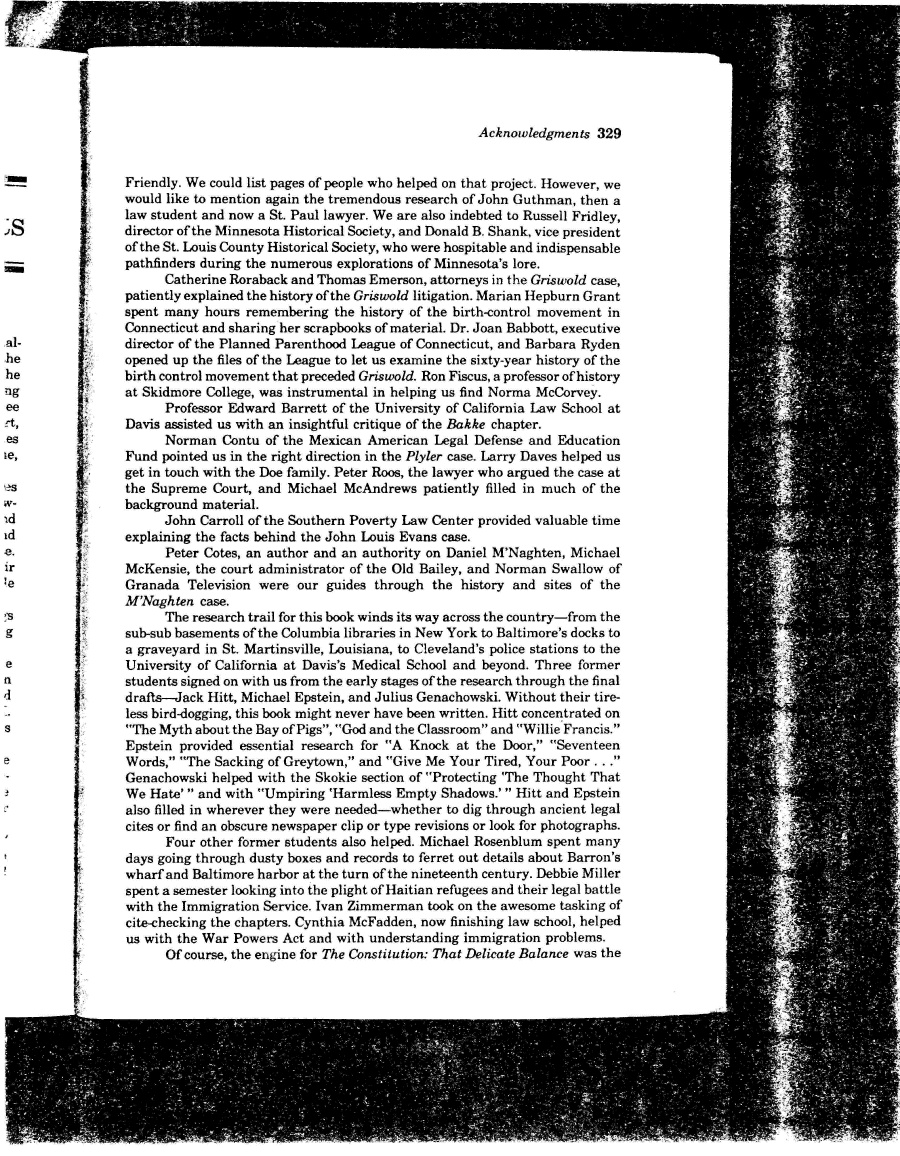|
Acknowledgments 329
Friendly. We could list pages of people who helped on that project. However, we
would like to mention again the tremendous research of John Guthman, then a
law student and now a St. Paul lawyer. We are also indebted to Russell Fridley,
director of the Minnesota Historical Society, and Donald B. Shank, vice president
of the St. Louis County Historical Society, who were hospitable and indispensable
pathfinders during the numerous explorations of Minnesota's lore.
Catherine Roraback and Thomas Emerson, attorneys in the Griswold case,
patiently explained the history of the Griswold litigation. Marian Hepburn Grant
spent many hours remembering the history of the birth-control movement in
Connecticut and sharing her scrapbooks of material. Dr. Joan Babbott, executive
director of the Planned Parenthood League of Connecticut, and Barbara Ryden
opened up the files of the League to let us examine the sixty-year history of the
birth control movement that preceded Griswold. Ron Fiscus, a professor of history
at Skidmore College, was instrumental in helping us find Norma McCorvey.
Professor Edward Barrett of the University of California Law School at
Davis assisted us with an insightful critique of the Bakke chapter.
Norman Contu of the Mexican American Legal Defense and Education
Fund pointed us in the right direction in the Plyler case. Larry Daves helped us
get in touch with the Doe family. Peter Roos, the lawyer who argued the case at
the Supreme Court, and Michael McAndrews patiently filled in much of the
background material.
John Carroll of the Southern Poverty Law Center provided valuable time
explaining the facts behind the John Louis Evans case.
Peter Cotes, an author and an authority on Daniel M'Naghten, Michael
McKensie, the court administrator of the Old Bailey, and Norman Swallow of
Granada Television were our guides through the history and sites of the
M'Naghten case.
The research trail for this book winds its way across the country—from the
sub-sub basements of the Columbia libraries in New York to Baltimore's docks to
a graveyard in St. Martinsville, Louisiana, to Cleveland's police stations to the
University of California at Davis's Medical School and beyond. Three former
students signed on with us from the early stages of the research through the final
drafts—Jack Hitt, Michael Epstein, and Julius Genachowski. Without their tire-
less bird-dogging, this book might never have been written. Hitt concentrated on
"The Myth about the Bay of Pigs", "God and the Classroom" and "Willie Francis."
Epstein provided essential research for "A Knock at the Door," "Seventeen
Words," "The Sacking of Greytown," and "Give Me Your Tired, Your Poor . . ."
Genachowski helped with the Skokie section of "Protecting 'The Thought That
We Hate' " and with "Umpiring 'Harmless Empty Shadows.' " Hitt and Epstein
also filled in wherever they were needed—whether to dig through ancient legal
cites or find an obscure newspaper clip or type revisions or look for photographs.
Four other former students also helped. Michael Rosenblum spent many
days going through dusty boxes and records to ferret out details about Barron's
wharf and Baltimore harbor at the turn of the nineteenth century. Debbie Miller
spent a semester looking into the plight of Haitian refugees and their legal battle
with the Immigration Service. Ivan Zimmerman took on the awesome tasking of
cite-checking the chapters. Cynthia McFadden, now finishing law school, helped
us with the War Powers Act and with understanding immigration problems.
Of course, the engine for The Constitution: That Delicate Balance was the
|

